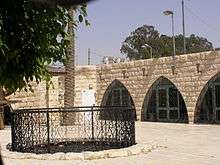Abraham's well
Coordinates: 31°14′14.01″N 34°47′35.08″E / 31.2372250°N 34.7930778°E
 | |
| Location | 2 Hebron road Beer Sheva |
|---|---|
| Type | history |
| Website | http://www.abraham.org.il/index.php?lang=en |
Abraham's well is one of a number of historical wells at Beersheba, Israel.
According to the bible, Abraham’s well was seized by Abimelech’s men (Genesis 21:25), and Isaac’s servants dug a well at Beer-sheba also (Genesis 26:25).
The well is near the Old city of Beer Sheva and Nahal Beer Sheva on the road to Eilat. It was identified in the 19th century by Edward Robinson in 1838.[1] In 1897, a local sheikh built a modern structure above the well.
Historical descriptions
Edward Robinson's description was as follows:[2]
These wells are some distance apart; they are circular, and stoned up with solid masonry. The larger one is twelve and a half feet in diameter and forty-four and a half feet deep to the surface of the water, sixteen feet of which, at the bottom, is excavated in the solid rock. The other well lies fifty-five rods W.S.W., and is five feet in diameter and forty-two feet deep. The water in both is pure and sweet, and in great abundance; the finest, indeed, we had found since leaving Sinai... Here then is the place where the patriarchs Abraham, Isaac, and Jacob often dwelt! Here Abraham dug perhaps this very well; and journeyed from hence with Isaac to Mount Moriah, to offer him up there in sacrifice
It was described by Claude Reignier Conder in the late 19th century as follows:[3]
...the principal well, which is twelve feet three inches in diameter, and over forty-five feet deep, lined with rings of masonry to a depth of twenty-eight feet. A second well, five feet in diameter, exists about 300 yards to the west, and on the east is a third, which is dry, twenty-three feet deep, and nine feet two inches in diameter. The sides of all the wells are furrowed by the ropes of the water-drawers; but we made one discovery which was rather disappointing, namely, that the masonry is not very ancient. Fifteen courses down, on the south side of the large well, there is a stone with an inscription in Arabic, on a tablet dated, as well as I could make out, 505 A.H., or in the twelfth century. This stone must be at least as old as those at the mouth, which are furrowed with more than a hundred channels by the ropes of seven centuries of water-drawers.
Gallery
References
- ↑ Jerusalem Post, TODAY IN HISTORY: THE ‘FATHER OF BIBLICAL GEOGRAPHY’; BENJAMIN GLATT; January 27, 2016
- ↑ "Biblical researches in Palestine, Mount Sinai and Arabia Petraea. A journal of travels in the year 1838". archive.org. Retrieved 2017-08-29.
- ↑ "Tent work in Palestine : a record of discovery and adventure". archive.org. Retrieved 2017-08-29.
External sources
| Wikimedia Commons has media related to Abraham well. |
